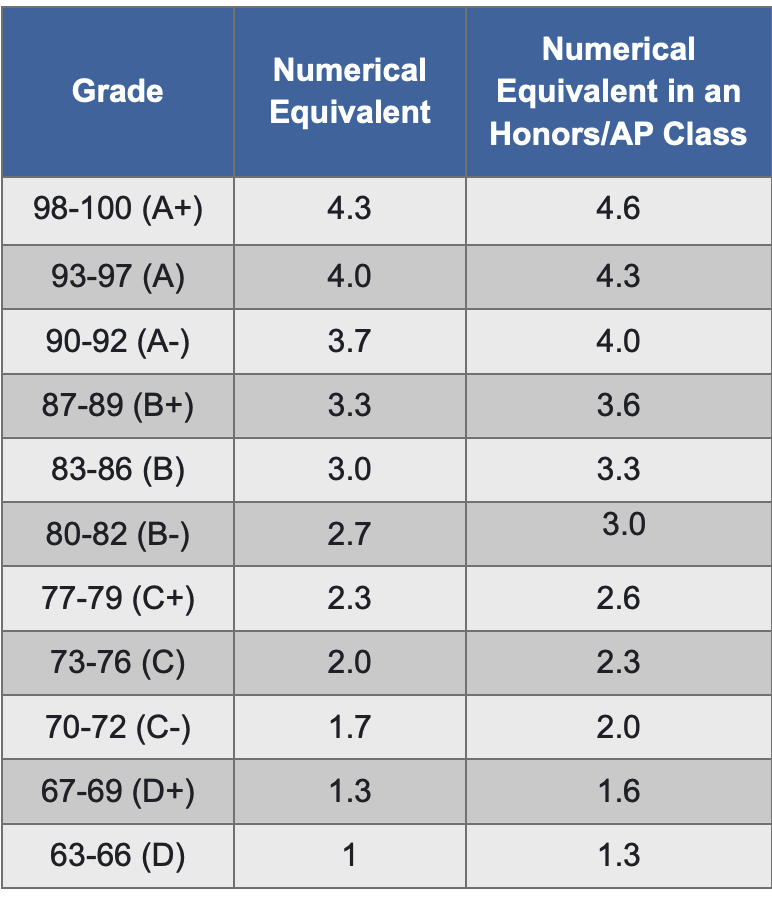Beginning with the class of 2025, the Upper School will resume sharing grade point average (GPA) calculations with students, a shift in its current practice that dates back to the 2017-18 school year. This decision came after months of deliberation within Academic Council, and Upper School students and families were notified of the decision by email on February 22.
This change was effective immediately. Weighted, cumulative ninth through 10th grade GPAs for the class of 2025 were added to their Scoir profiles by the end of February, and will be updated at the end of the academic year. The class of 2026, too, will find their cumulative ninth through 10th grade GPAs on their Scoir profiles at the end of the year which will then be updated accordingly after their junior year.
The College Counseling Department is still determining how GPAs will be shared on applications and whether they will include a student’s weighted GPA, unweighted GPA, or both; now, on Scoir, a student’s weighted GPA is visible only to the student, their family, and their college counselor. The primary use of this data point is to show students where their GPA falls in comparison to past MFS students who have been admitted to a particular university in order to better contextualize their chances of admission.
“If a student can see what their GPA is and compare it to past applicant data, that is a really helpful data point in determining potential odds of admission to a college, whether a school falls generally as a reach, target, or likely,” said LaTempa.
Prior to the 2017-18 school year, GPAs were calculated and included on students’ transcripts. The decision to discontinue this practice was made for two principal reasons: GPA calculation systems vary between high schools, and college admissions offices tend to recalculate students’ GPAs using their own scale.
By 2018, surrounding, similarly-sized independent schools including Germantown Friends School (GFS), Friends’ Central School (FCS), and William Penn Charter School were not reporting GPA to colleges, and some, including GFS and FCS, did not officially calculate GPA.
As of March 2024, these three schools do not report GPA.
Meredith Godley, Associate Head of School who held the position of Director of College Counseling during the 2017-18 school year, said that the rationale behind this initial switch was chiefly due to the skewed representation of the student body’s academic range through GPA calculation. “At a small school where you have fewer than 100 students in your senior class … who all went through a rigorous admissions process to get into the school, if you are essentially reporting GPA and showing what the range of GPA is, you’re really misrepresenting what our academic range is compared to students at schools where there are no prerequisites for getting in.”
All Upper School courses are designated at the base level as college preparation (CP) courses, and because this threshold of academic rigor is higher than the majority of U.S. secondary schools, “[MFS] students who, maybe, are in the bottom 50% of our GPA are going to be different than [the bottom 50%] at a school where there are no requirements for admission,” said Godley.
Yet, because GPA distribution is included within the school profile that colleges evaluate, a student’s GPA can be evaluated contextually. “When colleges see, for instance, that only 12 members of this year’s graduating class have a GPA at 4.0 or higher, it signals the rigor of our school, and colleges will typically honor that context,” said LaTempa.
Though the College Counseling Department has not included GPA on students’ end-of-year transcripts since 2017, GPA continued to be calculated internally for myriad uses. To determine Cum Laude Society inductees, GPA is looked at first. GPA calculations remained available to students if they needed to include their GPA on scholarship or summer program applications, or simply if they were curious. Additionally, students could choose to include their GPA on their Common Application, but it was not required.
At this time, Godley noted, “There was no signal that there was a disadvantage to students. There was actually a signal from colleges that it would be more advantageous to students.”
Why Was This Policy Reversed?
As explained in the February 22 email co-signed by US Director Noah Rachlin and Director of College Counseling Chris LaTempa, the college admissions landscape has since changed with respect to test-optional admission policy and an increased volume of applications.
“During the pandemic, many colleges and universities made the decision to no longer require standardized test scores as a part of a student’s application materials. With the exception of a small number of schools, this decision has persisted in the years since. Additionally, the broad use of standardized application forms such as the Common App has contributed to record-setting numbers of applicants to colleges and universities across the country. In response to this surge in applications and advances in technology, some colleges and universities have even begun to use artificial intelligence to conduct an initial review of student applications. In light of these changes, and through conversations with college admission professionals, we have received feedback that resuming the practice of calculating GPA for students to include in their application materials would better support applicants from MFS.”
With the holdover of test-optional policies following the COVID-19 pandemic, there are less quantitative measures to evaluate on a student’s application who opted out of submitting standardized testing scores. This shift in available student data puts more emphasis on the general context of a student’s course rigor and their GPA. “If you remove test scores from, in many cases, an application review, colleges have less to work on. So maybe colleges will [put] a little bit more focus on that GPA or just the transcript,” said LaTempa.
The substantial increase in college applications across the country coupled with the lack of submitted test scores, concurred Rachlin, has changed the college admissions landscape and merits the submission of a metric such as GPA. “[Colleges] are having to do some more work to gather relevant data at the same exact time [that] they’re having an increase in the number of applications … so they’re telling us that a calculation of GPA is one data point that we can provide that they find is helpful.”
These circumstances, coupled with consistent partnerships between the College Counseling Department and college representatives as well as college guidance networks, resulted in a reevaluation of GPA calculation. “We’ve been really attuned to those [circumstances], and the information that we receive, and in particular, a conversation about GPA and the fact that we weren’t sharing a calculated GPA,” explained Rachlin. “We picked that up as a school and began to talk about it in Academic Council.”
Academic Council, comprising administration and department chairs from all three divisions, is a body “focused on maintaining our academic program, considering different programs or options to improve the academic program,” said Godley, who serves as co-clerk along with Director of Teaching and Learning Jackie Dawson.
“[Academic Council] talked through … multiple discussions over many months of meetings, [about] what would be the benefits to providing GPA and making that information more readily available to students and families — but also to colleges — and what would be some of the negative potential ramifications?’” said LaTempa. “What we’re hearing from colleges, the decision was made that the positives would outweigh the negatives.”
This year, LaTempa said, he received messages from colleges requesting an applicant’s GPA. “When a college reaches out to ask, that is a case when we would absolutely provide it. We were told in those cases that providing the GPA would help the student. So, I think given those anecdotes, it seemed to make a lot of sense to provide the GPA.”
With the decision to share calculated GPA, LaTempa and Rachlin acknowledged that the “topic of grades” has the potential to create an “adversarial dynamic between students and teachers, and … they can also reinforce a fixed mindset that ultimately undermines student learning,” as per their email.
Developed by Dr. Carol Dweck, a fixed mindset causes someone to “[view intelligence, abilities, and talents] as inherently stable and unchangeable over time,” according to Harvard Business School.
Godley explained that although GPA is a metric that contributes to competition among students, this is a manageable phenomenon. “The more we can talk to them about their individual process and their individual growth and really focusing on what an accomplishment is for them, not compared to other people … the better off students will be, and the more they’ll be able to handle some of these points that I think traditionally give kids validation when they compare themselves to one another.”
“There are always going to be variables that lead to competition among students,” said Godley, “and we’re always going to be trying to encourage students to really look at their process, or even their academic growth here over four years in the upper school, individually.”







